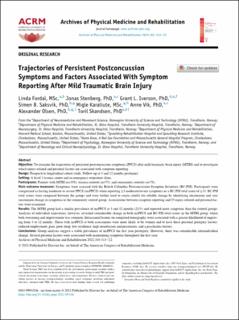| dc.description.abstract | Objective To examine the trajectories of persistent postconcussion symptoms (PPCS) after mild traumatic brain injury (MTBI) and to investigate which injury-related and personal factors are associated with symptom reporting. Design Prospective longitudinal cohort study. Follow-up at 3 and 12 months postinjury. Setting A level 1 trauma center and an emergency outpatient clinic. Participants Patients with MTBI (n=358), trauma controls (n=75), and community controls (n=78). Main outcome measures Symptoms were assessed with the British Columbia Postconcussion Symptom Inventory (BC-PSI). Participants were categorized as having moderate to severe PPCS (msPPCS) when reporting ≥3 moderate/severe symptoms or a BC-PSI total score of ≥13. BC-PSI total scores were compared between the groups and were further used to create cutoffs for reliable change by identifying uncommon and very uncommon change in symptoms in the community control group. Associations between symptom reporting and 25 injury-related and personal factors were examined. Results The MTBI group had a similar prevalence of msPPCS at 3 and 12 months (21%) and reported more symptoms than the control groups. Analyses of individual trajectories, however, revealed considerable change in both msPPCS and BC-PSI total scores in the MTBI group, where both worsening and improvement was common. Intracranial lesions on computed tomography were associated with a greater likelihood of improving from 3 to 12 months. Those with msPPCS at both assessments were more likely to be women and to have these personal preinjury factors: reduced employment, pain, poor sleep, low resilience, high neuroticism and pessimism, and a psychiatric history. Conclusions Group analyses suggest a stable prevalence of msPPCS the first year postinjury. However, there was considerable intraindividual change. Several personal factors were associated with maintaining symptoms throughout the first year. | en_US |

